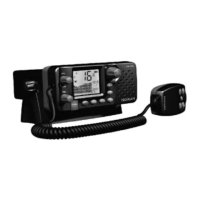
Do you have a question about the Navman VHF 7200 and is the answer not in the manual?
| Brand | Navman |
|---|---|
| Model | VHF 7200 |
| Category | Marine Radio |
| Language | English |
Outlines the various options available within the radio's main menu structure.
Describes how to add, edit, and delete contacts in the radio's buddy list.
Explains how to adjust receiver sensitivity for local or distant reception.
Covers adjusting screen brightness and contrast for optimal viewing.
Details how to configure GPS position and local time settings.
Explains how to switch the time display on or off on the screen.
Explains how to switch the vessel position display on or off.
Details how to display course over ground (COG) and speed over ground (SOG).
Covers setting up GPS alerts for receiver disconnection.
Explains how to enable and use the GPS simulator feature for testing.
Describes the process of restoring radio settings to their original factory state.
Explains how to edit or delete channel name tags displayed on the screen.
Details how to adjust the volume for incoming call notifications and system beeps.
Describes how to switch the radio's internal speakers on or off.
Explains how to configure the watch mode for scanning priority channels.
Covers setting up the radio to receive weather alerts from NOAA.
Details how to configure communication protocols for connected instruments.
Explains the barometric sensor and display options for weather prediction.
Describes how to customize the temperature units displayed by the radio.
Lists the key functionalities and capabilities of the Navman VHF radio.
Explains how to personalize radio settings and preferences.
Provides instructions on accessing and moving through the radio's menu system.
Details the methods for inputting text and numbers into the radio.
Explains the various icons and indicators displayed on the radio's LCD screen.
Covers fundamental operations and the functions of key buttons on the radio.
Lists the available configuration options within the DSC setup menu.
Guides on entering the unique Marine Mobile Service Identity for DSC functions.
Explains how to create, edit, and delete groups of contacts for DSC calls.
Allows setting automatic or manual responses to incoming individual calls.
Details entering the ATIS MMSID and enabling ATIS for inland waterways.
Covers enabling or disabling the overall DSC operational capability.
Sets how the radio responds to incoming Location polling requests.
Explains how to mute audible notifications for incoming data.
Provides a general explanation of Digital Selective Calling (DSC) technology.
Details the procedures for initiating various types of DSC calls.
Details how to handle various types of incoming DSC calls.
Provides step-by-step instructions for initiating a DSC distress call.
Explains how to receive and react to an incoming DSC distress call alert.
Describes how to acknowledge or relay a received distress call or alert.
Covers general power, current, and channel usage specifications.
Details LCD display size, dimensions, weight, and waterproof rating.
Lists key features like flush mount, local/distant control, and GPS integration.
Addresses common problems like power, audio, transmission, and GPS issues.
Lists international VHF marine channel frequencies and their uses.
Provides a list of VHF marine channels used in the USA and their traffic types.
Clarifies usage rules and limitations for specific channels in the USA.
Lists VHF marine channels used in Canada and their designated traffic types.
Clarifies usage rules and limitations for specific channels in Canada.
Details country-specific channel information for European inland waterways.
Provides general notes on channel usage and service categories.
Explains the meaning of footnotes used in the VHF marine channel tables.
Outlines the necessity of obtaining a user MMSID and radio license.
Provides contact details for Navman in various global regions.
Provides contact details for Navman's global headquarters in New Zealand.